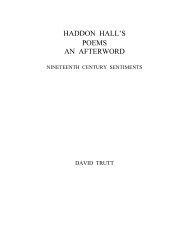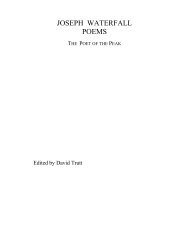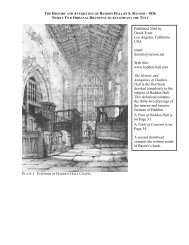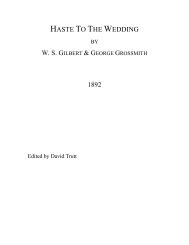Download - Haddon Hall
Download - Haddon Hall
Download - Haddon Hall
You also want an ePaper? Increase the reach of your titles
YUMPU automatically turns print PDFs into web optimized ePapers that Google loves.
26 PART III EARLY HISTORY OF HADDON HALL BY S. RAYNER<br />
HADDON is situated in the parish of Bakewell, and it was anciently included in the<br />
extensive manor or lordship of Bakewell. This appears from the survey of Derbyshire<br />
contained in the Doomsday Book, which was completed about 1086, after William the<br />
Norman [William the Conqueror, also William I, reigned 1066-1087] had extended his<br />
sovereign authority over the whole kingdom. The following extract from this national<br />
record shows that Bakewell, at the period in question, was one of the royal manors.<br />
“King Edward (the Confessor) [reigned 1042-1066] had in the manor of Bakewell 18<br />
carucates [a carucate = 120 acres], or plough-lands, with 8 Bartons [farms] for which he<br />
received rent. The land is estimated at 18 carucates. The King [William I] has now in<br />
demesne [ownership], 7 carucates, with 33 Villagers, and 9 Bordars [feudal tenants].<br />
There are 2 Priests and a Church, having under them 2 Villagers and 5 Bordars; all these<br />
having 11 carucates. One Knight there has 16 acres of land and 2 Bordars. There is 1<br />
Mill, at the rent of 10s 8d; and 1 Lead-work; and about 20 acres of meadow. The little<br />
wood is one furlong in length, and one in breadth. Three carucates of this land belong to<br />
the Church. Henry de Ferrers is assessed at 1 carucate in <strong>Haddon</strong>. The following are the<br />
8 farms of this manor — Cronkesden-grange [in Hartington]; Burton [near Bakewell];<br />
Oneash; Moneyash; Holmhall; Great Rowsley; Hadun [Over <strong>Haddon</strong>]; Haduna [Nether<br />
<strong>Haddon</strong>, including <strong>Haddon</strong> <strong>Hall</strong>].”<br />
The Manor of Bakewell was given by William I to his natural [born out of wedlock]<br />
son William Peverell on whom he had previously bestowed very extensive domains, in<br />
Derbyshire and other counties. As the Doomsday survey was commenced in 1081, and<br />
William I died in September 1087, it is obvious that this donation must have occurred<br />
during the intervening period. The individual who, through the bounty of his father thus<br />
became one of the great barons and chief landed proprietors of the country, living at a<br />
time when the use of surnames was becoming common (among the Normans), adopted<br />
that of the family into which, probably after his birth, his mother had married. From the<br />
researches of the celebrated heraldic historian and antiquary Sir William Dugdale (1605-<br />
1686), we learn the ensuing circumstances relative to this once noble and distinguished<br />
race of the English Baronage.<br />
PEVERELL OF NOTTINGHAM. “The first of this name of whom I find mention is<br />
Ranulph Peverell, who, at the time of the Conqueror’s survey, held four Lordships in<br />
Com. Salop, six in Norfolk, nineteen in Suffolk, and thirty-five in Com. Essex. Which<br />
Ranulph was the reputed progenitor of the several families of that name: for having<br />
married Maud, daughter of Ingelric (founder of the Collegiate Church of St. Martins le<br />
Grand, in the City of London), who had been a concubine to William [I] of Normandy,<br />
not only those children which he had by her, but that very William, begotten on her by<br />
the same Duke, before his conquest of this realm, had the name of Peverell.”







